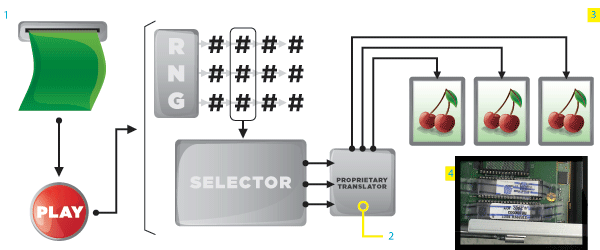
It takes a mathematician to fully appreciate the complex algorithms and calculations of randomness and probability that take today’s video slots far beyond the one-arm bandits of old.
“A slot machine is basically a mathematical model,” says Eric Weiss, administrator of the Technical Services Bureau (in the Division of Gaming Enforcement) that tests New Jersey’s roughly 37,000 slot machines for compliance with state regulations.
The Liberty Bell slot machine pioneered by San Franciscan Charles Fey in the late nineteenth century used three mechanical reels that slowed to an unpredictable stop through friction. Today’s video slots boast as many as five virtual reels as well as multiple lines of play, diagonal and horizontal. Each of Fey’s reels held five printed symbols. Today’s virtual reels can contain any number of symbols, though 10 to 15 is normal. Instead of friction, the reels are stopped by commands from software, which breaks down randomly generated numbers into smaller numbers linked to each symbol on a reel. Each symbol can be linked to one, a few, or many of these reduced numbers. By determining how many such numbers are linked to each symbol in a winning combination, casinos control the odds of winning.
1. Randomizing
Deposit cash or gaming voucher, hit play. In a three-reel machine, the software grabs the next set of three numbers produced by the Random Number Generator (RNG), which spews out thousands of numbers each second whether the machine is being played or not. This puts the lie to a common misconception: If you walk away from a machine and someone steps up and hits the jackpot on one “pull,” you would have won if you had played one more time. No, outcomes are not linked to each other or to the number of plays—only to the set of random numbers plucked from the stream on each play.
2. Stopping
The sets of numbers produced by the RNG can contain as many as 12 digits each. Every game manufacturer has a proprietary program that breaks down the three vast RNG numbers (in a three-reel machine) into smaller units of one, two, or three digits. These are called virtual stops, virtual because there are far more of them than there are symbols on a reel. Perfect randomness probably does not exist, but Weiss’ lab certifies as random a flow of numbers in which no pattern can be detected but in which all outcomes appear proportionally over a simulation of thousands of spins.z
3. Winning
New Jersey law requires that each machine pay out a minimum of 83 percent of money bet over the lifetime of the machine (defined as the time required for all possible combinations to come up once—sometimes weeks or months, but a maximum of six years). For competitive reasons, most casinos set payout percentage higher: in the high 80s to low 90s. To add intrigue, casinos position machines of varying payout percentage around the floor.
4. Tampering
Manufacturers submit a prototype of any new machine to Weiss’ lab for testing. If it passes, the lab uses Game Authentication Terminal (GAT) software to capture and store a digital signature of the product. When actual machines are delivered to the casino, lab techs compare the stored GAT to the GAT the machine produces. If they are identical, the inspector seals the circuit board with tamperproof tape. No changes can be made without breaking the seal. If a casino wants to, say, adjust payout percentage, it must be done in the presence of a lab tech.
